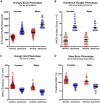Selection of Antiobesity Medications Based on Phenotypes Enhances Weight Loss: A Pragmatic Trial in an Obesity Clinic
- PMID: 33759389
- PMCID: PMC8168710
- DOI: 10.1002/oby.23120
Selection of Antiobesity Medications Based on Phenotypes Enhances Weight Loss: A Pragmatic Trial in an Obesity Clinic
Erratum in
-
Selection of antiobesity medications based on phenotypes enhances weight loss: A pragmatic trial in an obesity clinic.Obesity (Silver Spring). 2021 Sep;29(9):1565-1566. doi: 10.1002/oby.23236. Epub 2021 Jun 22. Obesity (Silver Spring). 2021. PMID: 34156162 Free PMC article. No abstract available.
-
Selection of antiobesity medications based on phenotypes enhances weight loss: a pragmatic trial in an obesity clinic.Obesity (Silver Spring). 2022 Jul;30(7):1521. doi: 10.1002/oby.23498. Epub 2022 May 25. Obesity (Silver Spring). 2022. PMID: 35611684 No abstract available.
Abstract
Objective: Little is known about the predictors of response to obesity interventions.
Methods: In 450 participants with obesity, body composition, resting energy expenditure, satiety, satiation, eating behavior, affect, and physical activity were measured by validated studies and questionnaires. These variables were used to classify obesity phenotypes. Subsequently, in a 12-month, pragmatic, real-world trial performed in a weight management center, 312 patients were randomly assigned to phenotype-guided treatment or non-phenotype-guided treatment with antiobesity medications: phentermine, phentermine/topiramate, bupropion/naltrexone, lorcaserin, and liraglutide. The primary outcome was weight loss at 12 months.
Results: Four phenotypes of obesity were identified in 383 of 450 participants (85%): hungry brain (abnormal satiation), emotional hunger (hedonic eating), hungry gut (abnormal satiety), and slow burn (decreased metabolic rate). In 15% of participants, no phenotype was identified. Two or more phenotypes were identified in 27% of patients. In the pragmatic clinical trial, the phenotype-guided approach was associated with 1.75-fold greater weight loss after 12 months with mean weight loss of 15.9% compared with 9.0% in the non-phenotype-guided group (difference -6.9% [95% CI -9.4% to -4.5%], P < 0.001), and the proportion of patients who lost >10% at 12 months was 79% in the phenotype-guided group compared with 34% with non-phenotype-guided treatment group.
Conclusions: Biological and behavioral phenotypes elucidate human obesity heterogeneity and can be targeted pharmacologically to enhance weight loss.
Trial registration: ClinicalTrials.gov NCT03374956.
© 2021 The Obesity Society.
Conflict of interest statement
Phenomix Sciences has obtained an exclusive license to AA and MC’s biomarker technology, submitted patent, and know‐how to develop a biomarker to predict response to obesity pharmacotherapy. Additionally, AA is a stockholder in Gila Therapeutics and Phenomix Sciences; he serves as a consultant for Rhythm Pharmaceuticals and General Mills. MC is a stockholder in Phenomix Sciences and Enterin and serves as a consultant to Takeda, Allergan, Kallyope, GlaxoSmithKline, Rhythm, and Arena with compensation to Mayo Clinic. MMC is a consultant for Roche Diabetes Care GmbH. BAD has served as a consultant for Boston Scientific, Metamodix, BFKW, DyaMx, and USGI Medical; has received research support for Boston Scientific, Apollo Endosurgery, USGI, Spatz Medical, GI Dynamics, Caim Diagnostics, Aspire Bariatrics, and Medtronic; and has been a speaker for Johnson & Johnson, Endogastric Solutions, and Olympus. The other authors declared no conflict of interest.
Figures



Similar articles
-
Overview of new antiobesity drugs.Expert Opin Pharmacother. 2014 Oct;15(14):1975-8. doi: 10.1517/14656566.2014.946904. Epub 2014 Aug 6. Expert Opin Pharmacother. 2014. PMID: 25100293 Review.
-
Long-term effects of weight-reducing drugs in people with hypertension.Cochrane Database Syst Rev. 2016 Mar 2;3:CD007654. doi: 10.1002/14651858.CD007654.pub4. Cochrane Database Syst Rev. 2016. Update in: Cochrane Database Syst Rev. 2021 Jan 17;1:CD007654. doi: 10.1002/14651858.CD007654.pub5. PMID: 26934640 Updated. Review.
-
Behavioral and Pharmacotherapy Weight Loss Interventions to Prevent Obesity-Related Morbidity and Mortality in Adults: An Updated Systematic Review for the U.S. Preventive Services Task Force [Internet].Rockville (MD): Agency for Healthcare Research and Quality (US); 2018 Sep. Report No.: 18-05239-EF-1. Rockville (MD): Agency for Healthcare Research and Quality (US); 2018 Sep. Report No.: 18-05239-EF-1. PMID: 30354042 Free Books & Documents. Review.
-
Prevalence of Antiobesity Treatment and Weight-Inducing Antihyperglycemic Agents Among Patients With Type 2 Diabetes in the United States.Clin Ther. 2022 Mar;44(3):e35-e44. doi: 10.1016/j.clinthera.2022.01.003. Epub 2022 Jan 30. Clin Ther. 2022. PMID: 35105470
-
THE BENEFIT OF SHORT-TERM WEIGHT LOSS WITH ANTI-OBESITY MEDICATIONS IN REAL-WORLD CLINICAL PRACTICE.Endocr Pract. 2019 Oct;25(10):1022-1028. doi: 10.4158/EP-2019-0081. Epub 2019 Jun 26. Endocr Pract. 2019. PMID: 31241358
Cited by
-
Case report of a female western Indian vegetarian with obesity.Obes Pillars. 2024 Oct 1;12:100137. doi: 10.1016/j.obpill.2024.100137. eCollection 2024 Dec. Obes Pillars. 2024. PMID: 39469669 Free PMC article.
-
Sex as an independent variable in the measurement of satiation: a retrospective cohort study.Int J Obes (Lond). 2022 Dec;46(12):2156-2162. doi: 10.1038/s41366-022-01228-7. Epub 2022 Oct 13. Int J Obes (Lond). 2022. PMID: 36229642 Free PMC article.
-
Effective and appropriate use of weight loss medication in pediatric obesity: a narrative review.J Yeungnam Med Sci. 2024 Jul;41(3):158-165. doi: 10.12701/jyms.2024.00353. Epub 2024 Jul 2. J Yeungnam Med Sci. 2024. PMID: 38952016 Free PMC article.
-
Obesity: A Review of Pathophysiology and Classification.Mayo Clin Proc. 2023 Dec;98(12):1842-1857. doi: 10.1016/j.mayocp.2023.05.026. Epub 2023 Oct 11. Mayo Clin Proc. 2023. PMID: 37831039 Free PMC article. Review.
-
Early Life Energy Balance: The Development of Infant Energy Expenditure and Intake in the Context of Obesity.Curr Obes Rep. 2024 Dec;13(4):743-754. doi: 10.1007/s13679-024-00591-y. Epub 2024 Oct 23. Curr Obes Rep. 2024. PMID: 39443348 Review.
References
Publication types
MeSH terms
Substances
Associated data
Grants and funding
LinkOut - more resources
Full Text Sources
Other Literature Sources
Medical

